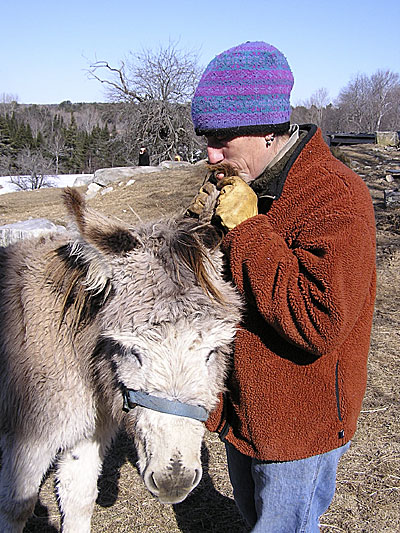 |
| Kennedy values Daisy, a Christian donkey, for her friendliness and her ability to warn when sheep predators approach the farm. English photo. |
by Jean English
On 80 acres of woods, wetlands and pasture just seconds from Route 17 in Washington, Maine, Nanney Kennedy has spent 20 years creating her peaceful, sustainable and productive Meadowcroft Farm. Here, sun grows grass that feeds sheep that produce wool that becomes yarn, blankets and sweaters – all dyed using sea water and solar heat. Animal manure supports alfalfa and pasture growth, which, in turn, continues to feed the sheep, a few of which end up in stews, roasts or sausages that Kennedy and her farmers’ market customers eat.
Rooted in Maine
Born in Damariscotta, Kennedy grew up in Nobleboro, Maine, in a 1790s farmhouse at Camp Kieve. Her grandfather came to Maine in the 1930s after graduating from Princeton to start Kieve as a character-building camp for boys. Kennedy’s father grew up there, too, with the old ways – cutting ice for refrigeration in winter, for example, and, like his father, working as a Maine Guide.
Kieve attracted many sons of notable people, so Kennedy was connected to the “outside” world as she met and talked with these boys; but while they did their boys’-only activities, she got to enjoy the peaceful nature of Maine, boating and roaming the woods and fields on her own.
“I could see where the stone fences were. I gobbled all the books by Elizabeth Coatsworth. She was my mentor of how life had been on that peninsula. I would go find these places where the kids [in her books] would play. Total fantasy world, perfect! And I got wonderful nature books and would go out in my back yard and explore.”
Given its natural fencing (water), Nobleboro was “covered with sheep when my Dad was living there,” says Kennedy. The forestry and shipbuilding industries had essentially denuded Maine in the 19th century, opening land for sheep. Boston was the seat of the apparel wool trade then, “so there were tons of sheep in this part of the world. By the time I was a kid, we were raising cattle there.” (The carpet wool trade, on the other hand, was located in Philadelphia.) By the early ‘70s, when the old fences failed to keep the cows out of Kennedy’s mother’s peonies, the animals were replaced with Christmas trees.
During the school year, her parents taught at the Pingree School in Hamilton, Mass., so Kennedy and her brother were educated there, further connecting to the world outside Maine. At the end of the school year and on weekends and vacations, they would return to their unheated Maine house where, on chilly nights, “we would sleep under mounds of blankets.”
After high school, Kennedy got her B.A. in the sociology of art from Bowdoin College, where a folklore class gave her an appreciation for wooden boat building and other creative enterprises. The notion “of creating a life for yourself that was also manufacturing, working with your own ingenuity, taking a resource product” prompted her to ship out to New Zealand in 1982 and spend six months learning about raising sheep, managing pasture and breeding for fiber on an animal that is well naturalized to its environment.
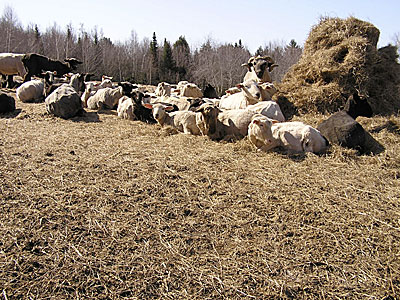 |
| Kennedy’s sheep are raised on pasture and, in winter, on harvested hay and balage. Here, newly shorn sheep rest in the sun on a warm, well-drained hilltop where they have plenty of hay. English photo. |
The Sheep Farmer and His Wife
“I always had an affinity for animals,” says Kennedy, having grown up in an area rich in farm stock, so the opportunity to work on a 2,500-acre, 8,000-sheep station (with up to 16,000 sheep during lambing season) was a natural fit. She learned the importance of keeping sheep clean so that their fleeces would be more valuable. She went to shearing school. She tended the horses on the farm and rode them to tend the Romney sheep on the home 1,000 acres, while the farmer rode his motorbike over more distant land to tend the rest of the flock.
“He taught me a tremendous amount about fiber dynamics and his breeding program. I went to different breeders and heard what they had to say about breeding in a grass-based system; about letting Mother Nature take its course so that you have a healthy herd; the importance of not poking [the sheep] full of antibiotics every time you turn around.”
The farmer’s German wife, “a wonderful hand spinner, fiber artist,” was another inspiration – not only for her handiwork, but also for her colored flock. “Whenever they had black sheep in New Zealand,” Kennedy explains, “they’d usually go into the stew pot,” since New Zealand is known on the international market for its white wool, which can readily be dyed. “When you’re working in a wool shed, even if you get a little black spot of wool, one of the shearers would grab it and say, ‘Black wool!’ and a rouser would grab it and get it out of the wool.”
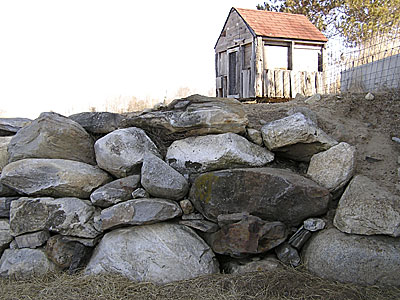 |
| Sheep can wander down this “ha-ha” into a yard that is protected from wind and that borders an open barn, where they have access to more hay. English photo. |
The German woman, however, kept the black sheep and developed “an incredible colored flock,” says Kennedy. “They had the first Moorit (“Max”) I’d ever seen, which is a double recessive colored gene. In the world of sheep, white is dominant, black is recessive, gray is recessive to black and Moorit is double recessive, which is like a red-haired animal. Sheep also have genes for color patterning, producing spots, streaks, or big colored splotches (as in Jacob sheep) on their bodies.”
Fascinated by the genetics of sheep, the woman kept breeding for finer and finer, shinier, softer Romney wool. “She saw how quickly the fiber would respond, and she showed me how, generationally, it would respond.” She helped start the New Zealand Black and Colored Sheep Society, which, now international, holds a World Congress every five years – once on that New Zealand farm. “It really started because of Max, that Moorit ram,” says Kennedy. “People would bring their sheep there to have Max breed.” Kennedy thrived on the science, physical work and spiritual connection to animals and the land.
Building Her Own Business
“I started thinking about what I wanted to do to make a living in Maine,” says Kennedy. “The things that really mattered to me were those fundamental values that I’d been raised with, resource industries, being able to appreciate good, clean, ecological systems. I love systems approaches” – possibly a genetic trait: One ancestor, Hiram Sibley, founded Western Union so that the North could communicate during the Civil War. As he and his trains and telegraph went west, he financed tenant, family farmers, built infrastructure such as large corncribs, and started The Sibley College of Mechanic Arts of Cornell University to train farmers and others.
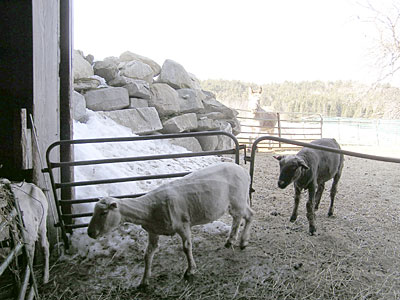 |
| In the barnyard, entering the barn. English photo. |
Raising sheep made sense to Kennedy, because they produce at least two products, “and I really love fiber. Yarns were a nonperishable product that was easy to ship, that didn’t break, and I could harness the summer green pastures – all of this wonderful grass that we can grow in Maine; I could raise the animals, completely grass-fed on that all summer; and, as ruminants, they thrive on well-grown and harvested grass silage during the winter.”
Kennedy’s affinity for animals helped, too. “There were so many aspects of working with the livestock that just clicked for me. And the animals respond. You can go to farms and see and feel the chaos in some. Some people who are drawn to animals don’t have an alpha presence to them. I tend to be quite alpha – which can make fitting into the world difficult, but works well with the livestock. Truly they are very calm. They know there’s a system, they know they’re going to get fed. They need a strong person – not to manipulate them and push them around, but to be in control.”
Returning to Maine, she worked as the night shepherd for the Forbes family on Naushon Island and took correspondence courses in agriculture from Pennsylvania, then graduate courses at the University of Maine in agriculture and resource economics. At the many workshops and conferences she attended, she noticed that most of the people making money in agriculture were working for the industry and weren’t farmers. “The few farmers who were making money had inherited their capital and had enough savvy to work the system. There were a lot of really good farmers, but they may not have been greedy, or they may not have been good marketers. And the commodities that did best were things like dairy, which had an infrastructure, or market gardeners, whose basis is a seed at a fraction of a penny and whose biggest inputs are labor and love.
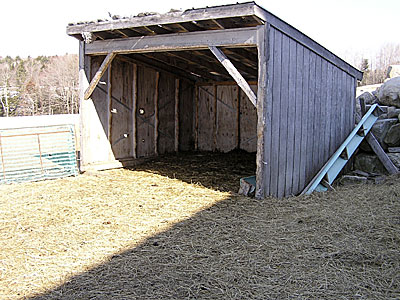 |
| A shed in the barnyard offers one more warm, protected place where sheep can congregate if they want. English photo. |
Still, Kennedy loved the idea of being an entrepreneur and decided to develop her own farm as something that could be a successful model for others. “The thing that is still most exciting about being in America is that you can present options to consumers, and consumers can choose in a way that can really make a difference. But if entrepreneurs aren’t willing to stick their neck out, we’re all going to live off of the big box stores for the rest of our lives and feel bad about it. The onus is on the consumers to make a difference.” That’s why she named her Web site GetWool (www.getwool.com). “It’s the consumer who makes the difference ultimately.”
Over 20 years, Kennedy has built a flock of about 100 sheep that she winters (150-plus after lambing), primarily Corriedales bred back to Merinos. She breeds away from the old-style range animal with a deep body cavity by, in the third cross, going back to a long-bodied type, such as a Leicester. On the range, deep bodies are desirable because they can carry more lambs, but Kennedy prefers that her ewes have singles: “A ewe raising one good lamb fits better on a pasture system” such as hers – with the Maine weather and soils and no synthetic chemical inputs.
Leicesters also have shinier, longer staple length wool. “Shiny fibers are straighter and less springy,” Kennedy explains. “Merino is very small diameter, has a tiny crimp and so is very springy. Wool that is too springy is hard to knit.” She now has six young rams to sell, in addition to a Moorit and a Coopworth in her homebred program, with very fine wool, because more people are interested in adding value by selling yarn but don’t necessarily have fine-wool breeds.
Sheep are divided into three groups soon after shearing: wethers (castrated males), pregnant ewes and hoggets (last year’s lambs) – partly because males eat more aggressively, and some females in the same area would defer to them. She does keep some animals with large mouths among those with smaller mouths. The larger mouths dig into a bale of hay and open it up for the smaller-mouthed, less powerful animals.
Before pastures green up, the sheep feed in warm, dry, sunny, protected, well-drained places. By grazing naturally off feed (hay and balage – grass silage, with a decent amount of clover in it) placed in these dry areas, the sheep have very little debris in their wool. Scattered balage minimizes erosion, and the sheep sleep on the dry material. They spread their own manure as they feed, saving Kennedy the trouble of cleaning a barn and spreading manure, and adding to the humus on windswept hills that would otherwise erode in spring. The balage comes from a nearby farm and from Kennedy’s own fields; each farm dresses its hayland only with manure.
The sheep can come into a shed or barn whenever they want, and more feed is available in troughs in the barn. In addition to having free choice feed, the sheep get Ration Maker mineral mix. They also get kelp meal during “the dark times” when Kennedy feels they need chlorophyll.
Lambing takes place in May, when the farm has abundant, mineral-rich grass and when ewes need the most feed for late gestation and lactation.
Kennedy rejected her training that an agricultural system must grow a product fast and get it to market. “I’m really growing wool, which is a completely renewable product, and I want to be able to do it as low-cost and sustainably as possible, in a way that’s constantly enriching the soil.” So her sheep eat only grass (no grain) and grow slowly – and she dyes her wool with solar heat rather than fossil fuels. “You can’t live off the land,” she says; “you have to learn to live with the land and restore it as you go, which is why I like to bring in additional feed as recycled nutrient material to offset wool and meat that is harvested here,” although, she adds, she see sheep as carbon-neutral or better, because they harvest much of their own feed, fertilize as they go, can enhance legume production in their pasture mix if they are properly grazed in rotation; and they produce a renewable product, which, when worn, recycles one’s own body heat more efficiently.
“The natural growth cycle of sheep, like cattle, is two years,” Kennedy explains. “But in this country, because we had such grain abundance, we created all these animals that go in a feedlot and are pushed, pushed, pushed. We created breeds that are pigs with wool. They’re designed to eat a lot of grain, to grow fast, to get to market weight in 120 days or fewer…”
Now with competition from afar, “I can’t possibly raise a leg of lamb for $1.29 a pound. I would rather raise a product I believe in. I’m ecstatic that there are now enough consumers out there who understand that.”
Her sheep are sheared after 10 months, and then lambs grow out at the same time that ewes are gestating and lactating – and when fresh pasture is abundant. Animals are evaluated for carcus quality, micron and other wool traits. “The hard decisions then get made. Some year-olds will go to slaughter, depending on consumer demand.” Grass-fed meat becomes available just as farmers’ market customers start coming, around the fourth of July.
Guard Animals
Coyotes – “Mother Nature’s extortionists,” according to Kennedy – are a constant threat to Maine sheep. Kennedy has double-fenced her pastures to exclude coyotes, and she has several guard animals: Daisy, a Christian donkey (because she has a cross on her back); Emma, a Great Pyrenees dog; and three horses (including a registered Paint and two Standardbreds, one rescued from the racetrack). Four border collies help move the flock.
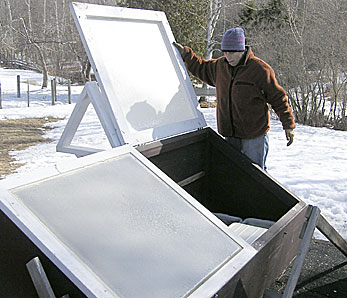 |
| Originally built as coldframes, these solar heated structures now supply heat to warm the dye bath for Kennedy’s Seacolors yarn. English photo. |
The horses and Daisy, with her bray, alert Kennedy to trouble by neighing, and one guards the sheep by rounding them up and then standing in the middle of the flock, making it look like a big organism with a tall head. “The only defenses sheep have are flight or flock,” says Kennedy. “So they flock together so that a predator thinks that they’re one large unit. It’s a whole different way of thinking about an organism or about organic structure and, in a very tangible way, realizing that we all rely on the other one. We are part of a whole.”
Solar-Dyed Seacolors
Kennedy’s Seacolors skeins of yarn make a display at farmers’ markets and the Common Ground Fair that is a work of art in itself. She explains that dyeing wool, a protein fiber, differs from dyeing vegetable fibers. Wool requires heat, salt and acids. “Instead of using chemical salts, I use seawater, and I use vinegars for acids. I trade time for temperature,” although her solar boxes – originally made as coldframes – also provide heat. The color comes from Reactive Dyes, which use sodium carbonate to bond.
Her dyeing techniques vary. “I might start semi-dry and then put the colors on so that they give these color burst areas, and then pour water on top; or I might start in a more wetted area. It depends on the day, the weather…” and results in delicately variegated color. “I don’t really like to standardize,” says Kennedy. She creates her hand-dyed yarns in 2- to 4-pound, one-of-a-kind lots.
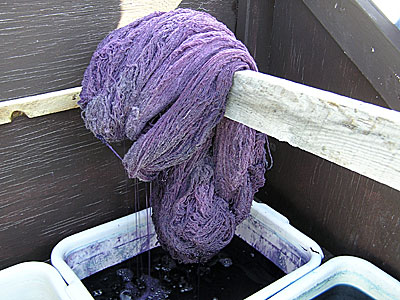 |
| Dyed with seawater, vinegar and nontoxic colors, Kennedy’s fine, soft wool yarn drips dry into vats so that the dye can be reused several times. English photo. |
The saltwater rinse captures any dye so that it can be reused repeatedly. Kennedy is setting up a system that will separate dye materials from the water, so that the water can be recycled to increase forage yield in an alfalfa stand.
The Maine Blanket
Kennedy’s second enterprise, incorporated separately from Seacolors, is The Maine Blanket – made from soft, durable, sustainably-raised wool. The blankets come in two sizes and are off-white with slightly variegated striping from Seacolors yarn in them. Brighter colors are used in the small blankets, more muted in the bed sized. Her son Benjamin names the designs – e.g., “Highland Mist.”
In addition to Kennedy’s sheep, some half dozen contract growers also supply wool for the blankets. “It’s always been my hope to develop good, residual markets for wool commodities that were better than the Wool Pool and had built into them a way of helping growers get a better value for their fiber and, if they did their work in both breeding and harvesting, they would be remunerated.”
Ever the entrepreneur, Kennedy recites her new marketing slogan for The Maine Blanket: “Local Warming: Got Body Heat, GETWOOL.”
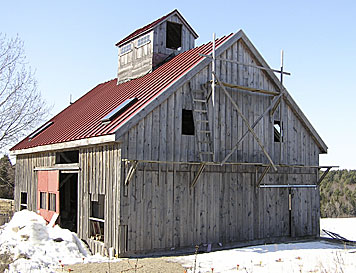 |
| Kennedy plans to turn this barn into an office, studio, apartment and showroom that will be open to the public. It will have space for handwork groups, for families who come to train their border collies, and for students who want to live on the farm. English photo. |
Marketing
Kennedy’s big challenge is meeting her costs, particularly for marketing, and finding customers who appreciate hand work “and the fact that you can, by knitting with the right yarn, be part of a sustainable system.”
She has found a number of appreciative customers at the Bath and Damariscotta Farmers’ Markets and especially at the Common Ground Fair. This year, she hopes to finish a barn that will house a studio, office, apartment and showroom that will be open to the public. The barn will have space for handwork groups, for families who come to train their border collies, and for students who want to live on the farm and learn about the flow of farm operations.
For more information, contact Nanney Kennedy & Sons, 45 Hopkins Road, Washington, ME 04574; (207) 845-2587, [email protected], www.getwool.com/seacolors/nanney.htm.
Sheep Congress Coming to Maine?
The next Black and Colored Sheep Society Congress is in Brazil, from Sept. 4-9, 2009. Kennedy hopes to organize a trip there for fiber enthusiasts; and she’d like to have the Congress come to Maine in 2014, “because I think we’re going to have enough of a fiber arts community.”
The Black Sheep Gathering on the West Coast of the United States is a similar, annual event that grew out of a World Congress in 1989 (www.blacksheepgathering.org); and Maine has its Fiber Frolic. Kennedy would like to build the 2009 Congress around the Fiber Frolic, and include a bus tour showing the history of the sheep, wool and mill culture in Maine and greater New England – how the social fabric of Maine evolved around sheep; how, during Reconstruction, that industry fell; and how we now have cheap imports – but “if we can still cobble together enough of a social fabric and an infrastructure, we can build it up again,” says Kennedy.
Counting Sheep
According to the New England Ag Statistics (www.nass.usda.gov/nh/agfeb05.txt), the New England sheep and lamb inventory on Jan. 1, 2005, totaled 45,500 head, up 2,500 from a year earlier, and the first increase in sheep numbers in the region since 1999. Breeding stock totaled 39,000 head, a 5% increase from 2004. Nationally, sheep numbers were above 2004 levels, supported by efforts to strengthen the sheep industry nationwide with a ewe-lamb replacement and retention program administered by the USDA Farm Service Agency (FSA). New England’s value of inventory was $9.1 million in 2004, compared with $8.4 million the previous year.
For comparison, the total number of sheep in Maine alone in 1836 was 622,619
(C. Benton and F.S. Barry, A Statistical View of the Number of Sheep in Several Towns and Counties in Maine…).
To learn more about Nanney Kennedy and her Meadowcroft Farm, read Shear Spirit: Ten Fiber Farms, Twenty Patterns, and Miles of Yarn, by Joan Tapper (Author) and Gale Zucker (Photographer), from Potter Craft, 2008. Kennedy’s farm is the subject of the first chapter in the book.
